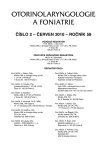-
Medical journals
- Career
Evaluation of Resection Margins and Their Predictive Value in Treatment of Oral Cavity Carcinoma
Authors: O. Bulik 1; M. Machálka 1; O. Liberda 1; Jiří Jarkovský 2; R. Foltán 3; J. Kyclová 4
Authors‘ workplace: Klinika ústní, čelistní a obličejové chirurgie LF MU a FN, Brno, přednosta doc. MUDr. M. Machálka, CSc. 1; Institut biostatistiky a analýz LF a PřF MU, Brno 2; Stomatologická klinika 1. LF UK a VFN, Praha 3; ÚPA – Patologie, FN, Brno 4
Published in: Otorinolaryngol Foniatr, 59, 2010, No. 2, pp. 72-76.
Category: Original Article
Overview
The evaluation of resection margins in surgical treatment of oral cavity carcinoma is an important prognostic factor. Sometimes it is difficult to perform the resection in the healthy tissue because of relatively small field of operation, presence of important anatomical structures in the region of oral cavity, and advanced stage of the oncogenic disease in most patients. The outcome of resection margin zone examination modifies individually further therapeutic procedure. Lot of studies point out both increased occurrence of relapses and overall survival outcome setback in patients with positive surgical margin with regard to the presence of tumor cells.
This paper analyses a file of 71 patients with oral cavity spinocellular carcinoma in whom the surgery was a treatment part of oncogenic disease. Either the occurrence or the tumor proximity in the resection margin was detected in 28.2 % of findings. Dates of 65 patients in total were processed with focus on local relapse occurrence during there years. In case of either positive or proximate margin a local relapse occurred in 47.4 % (9/19) of patients, in case of negative margin in local relapse occurred in 26.1 % (12/46) of patients. Positive or proximate margin occurred most frequently in category T3; upper alveolar process and palate was the most frequent localization, i.e. in 55.6 % (9/15) of patients. Expressive decrease in occurrence of local relapses was recorded in case of negative surgical margin.Key words:
oral cavity carcinoma, surgical margin,, surgical therapy evaluation, local relapse.
Sources
1. Brennan, A. J., Mao, L., Hruban, R. H., Boyle, J. O., Eby, Y. J., Koch, M. W., Goodman, S. N., Sidransky, D.: Molecular assessment of histopathological staging in squamous cell carcinoma of the head and neck. N. Engl. J. Med., 332, 1995, s. 429-435.
2. Ravasz, L. A., Slootweg, P. J., Hordijk, G. J., Smit, F., Tweel, I.: The status of the resection margin as a prognostic factor in the treatment of head and neck carcinoma. J. Cranio-Maxillofac. Surg., 19, 1991, s. 314-318.
3. Ribeiro, N. F. F., Godden, D. R. P., Wilson, G. E., Butterworth, D. M.: Do frozen sections help achieve adequate surgical margins in the resection of oral carcinoma? Int. J. Oral Maxillofac. Surg., 32, 2003, s. 152-158.
4. Sutton, D. N., Brown, J. S., Rogers, S. N., Vaughan, E. D., Woolgar, J. A.: The prognostic implications of the surgical margin in oral squamous cell carcinoma. Int. J. Oral Maxillofac. Surg., 32, 2003, s. 30-34.
5. Vikram, B., Strong, E. W., Shah, J. P., Spiro, R.: Failure at the primary site following multimodality treatment in advanced head and neck cancer. Head Neck Surg., 6, 1984, s. 720-723.
6. Weijers, M., Snow, G. B., Bezemer, D. P. et al.: The status of the deep surgical margins in tongue and floor of mouth squamous cell carcinoma and risk of local recurrence; an analysis of 68 patients. Int. J. Oral Maxillofac. Surg., 33, 2004, s. 146-149.
Labels
Audiology Paediatric ENT ENT (Otorhinolaryngology)
Article was published inOtorhinolaryngology and Phoniatrics

2010 Issue 2-
All articles in this issue
- Results of Cochlear Implantations in Deaf Blind Children
- Validity of HRCT and Surgery Findings in Pathology of Temporal Bone in Children
- Adenoid Vegetation and Chronic Secretory Otitis
- Epiglottitis in Adults
- Evaluation of Resection Margins and Their Predictive Value in Treatment of Oral Cavity Carcinoma
- Foramen Luschkae and Indication of Neuro–otologic Surgical Interventions
-
Report on Questionnaires on 72nd Congress of the Czech Society of Otorhinolaryngology and Head and Neck Surgery,
56th Congress of the Slovak Society of Otorhinolaryngology and Head and Neck Surgery,
3rd Czecho-Slovak Congress of Otorhinolaryngology - Relapsing Polychondritis, Manifestations in Otolaryngology Area
- Otorhinolaryngology and Phoniatrics
- Journal archive
- Current issue
- Online only
- About the journal
Most read in this issue- Epiglottitis in Adults
- Relapsing Polychondritis, Manifestations in Otolaryngology Area
- Adenoid Vegetation and Chronic Secretory Otitis
- Validity of HRCT and Surgery Findings in Pathology of Temporal Bone in Children
Login#ADS_BOTTOM_SCRIPTS#Forgotten passwordEnter the email address that you registered with. We will send you instructions on how to set a new password.
- Career

